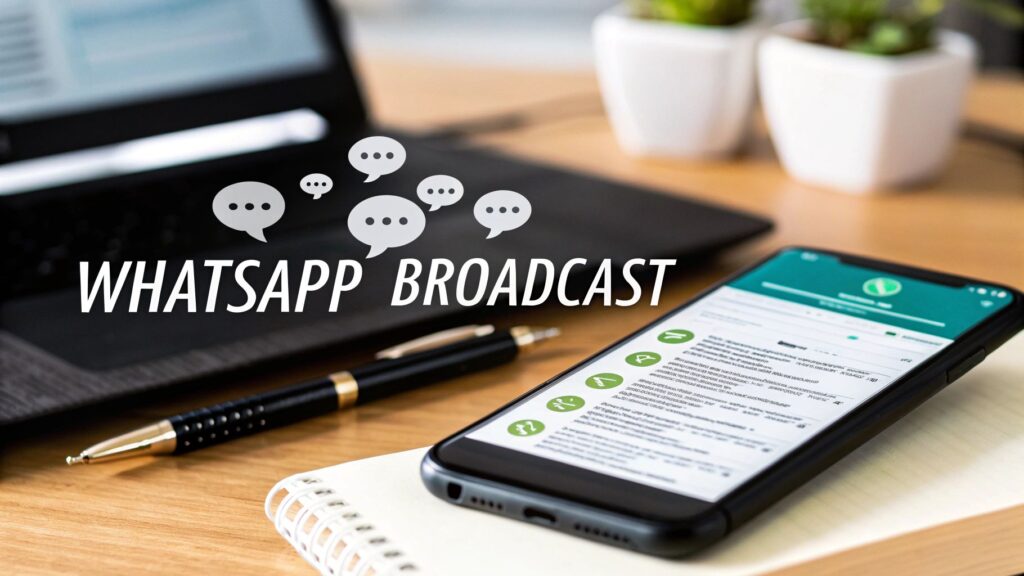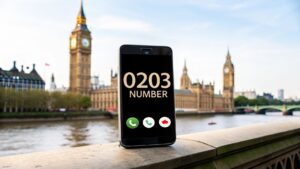A WhatsApp broadcast lets you send a single message to a list of contacts, but here's the clever part: it lands in their chat window as a private, one-to-one message. It’s not a group chat. Nobody sees who else got the message, making it a fantastic tool for businesses that want to communicate personally, at scale.
Why WhatsApp Broadcasts Beat Group Chats for Business
When you need to get a message out to your customers, using a broadcast is worlds apart from lumping everyone into a noisy group chat. While groups have their place for discussions, broadcasts offer a much cleaner, more professional way to communicate your key updates.
Imagine you want to announce a flash sale. In a group chat, that important message could be instantly buried under a flood of replies, questions, and off-topic conversations. A broadcast, on the other hand, drops that same offer neatly into each customer’s private chat with you. It feels personal and direct, like it was meant just for them.
This direct line is key to building better customer relationships. It respects their privacy, cuts through the digital clutter, and makes sure your message gets seen.
The Power of Personal, Private Communication
The real magic of a broadcast is how it combines mass outreach with a personal touch. When a customer reads your message, it looks just like any other private chat, prompting them to reply directly to you—and only you. This opens the door for genuine one-on-one conversations that are simply impossible in a group setting.
This approach also aligns perfectly with customer expectations in the UK, particularly around data privacy. It’s a win-win.
- Total Privacy: A recipient’s name and number are never visible to anyone else on the broadcast list.
- No Notification Spam: Customers won’t be annoyed by a constant stream of replies from others.
- Direct Line to You: Any response immediately starts a private conversation, perfect for closing a sale or answering a question.
The numbers are staggering. WhatsApp handles over 140 billion messages every single day across the globe. By using broadcasts, your business can tap into this massive network without sacrificing that all-important personal feel customers now expect. You can dig deeper into WhatsApp's communication scale on wanotifier.com.
The Golden Rule of Broadcasting
Now, there’s one non-negotiable rule you must know, and it underpins your whole strategy: your customers must have your business number saved in their phone's contacts. If they haven't, they won't get your message. Simple as that.
This isn't a bug; it's a core feature designed by WhatsApp to prevent spam. It means businesses have to earn the right to be in a customer's address book. This shifts your focus from just collecting numbers to building real trust and providing value, so people genuinely want to save your contact and hear from you again.
Laying the Groundwork for Effective Broadcasts
Before you send your first broadcast, you need to get the basics right. Your WhatsApp Business profile is your digital shopfront, and it’s often the first interaction a customer has with your brand. A complete, professional-looking profile builds instant trust and makes it far more likely that people will save your number.
Start by filling out every single detail. It might seem like a small task, but this is what separates a professional operation from a casual one.
- Business Hours: Be crystal clear about when you're open and available.
- Location: Add your address to build that local connection.
- Website Link: Make it easy for people to find your main online hub.
- Product Catalogue: This is a game-changer. Let people browse what you offer right there in the app.
Creating Smart Broadcast Lists
Once your profile is looking sharp, it's time to organise your contacts. A common mistake is lumping everyone into one massive broadcast list. A broadcast message in WhatsApp only works if it feels personal and relevant.
Think about segmenting your audience from day one. For instance, if you run a local gym, you could have separate lists for "Yoga Class Members," "Personal Training Clients," and "New Member Promotions." This way, you're sending messages people actually want to see, which keeps them engaged and stops them from blocking you.
So, what's the real difference between a broadcast list and a regular WhatsApp group? It’s a common point of confusion, but the distinction is crucial for business communication.
WhatsApp Group vs Broadcast List Key Differences
This quick table breaks down the key differences to help you decide which tool is right for the job.
| Feature | WhatsApp Group | WhatsApp Broadcast List |
|---|---|---|
| Privacy | All members can see each other's names and numbers. | Recipients cannot see who else is on the list. Messages are received privately. |
| Recipient Interaction | All members can reply, and everyone in the group sees the message. | Replies come directly and only to you, like a normal 1-to-1 chat. |
| Best For | Collaborative discussions, team projects, and community building. | One-way announcements, promotions, and updates to a large audience. |
| Message Delivery | All members of the group receive the message. | Only contacts who have your number saved in their phone will receive it. |
In short, groups are for conversations, while broadcasts are for announcements. Understanding this is fundamental to using WhatsApp effectively for your business.
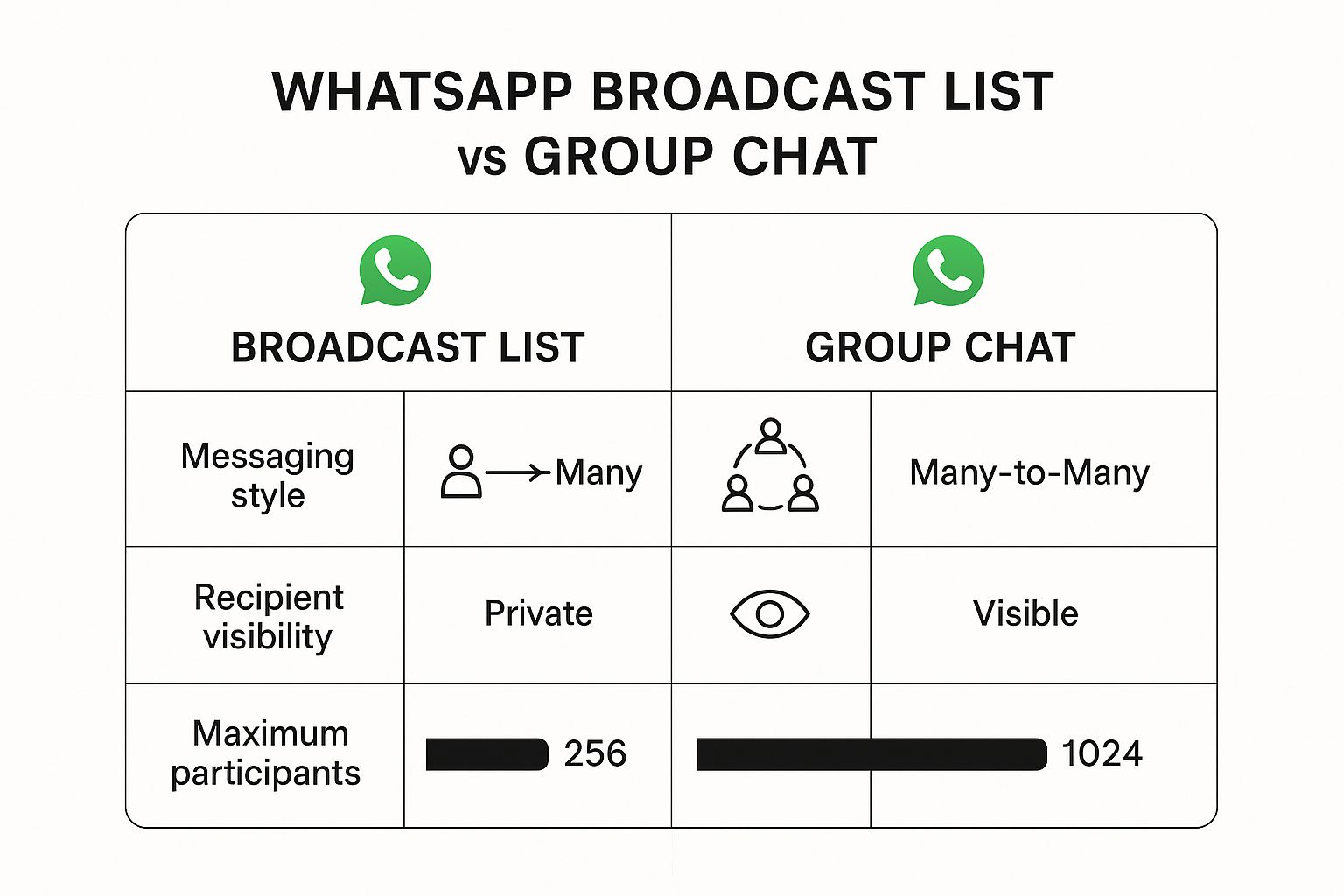
From a Contact List to a Community
Think of your broadcast lists less like a mailing list and more like mini-communities. Each segment is a group of people who share something in common, whether it’s what they bought or what they’re interested in.
When you segment your audience properly, you stop shouting into the void and start having meaningful conversations. You’re not just broadcasting; you’re delivering real value to the people who are most likely to appreciate it.
Here are a few ideas for lists you could create:
- Purchase History: Group your 'VIP Customers' for exclusive early-bird offers or 'First-Time Buyers' for handy tips on using their new product.
- Geographic Location: Perfect for notifying customers about a local pop-up shop or a region-specific delivery deal.
- Expressed Interest: Create a list for everyone who enquired about a particular service but didn't buy, so you can follow up with a special offer later.
Taking the time to set this up properly from the start is what makes every message you send feel welcome and relevant, turning a simple tool into a powerful part of your business.
Crafting Broadcasts That Connect and Convert
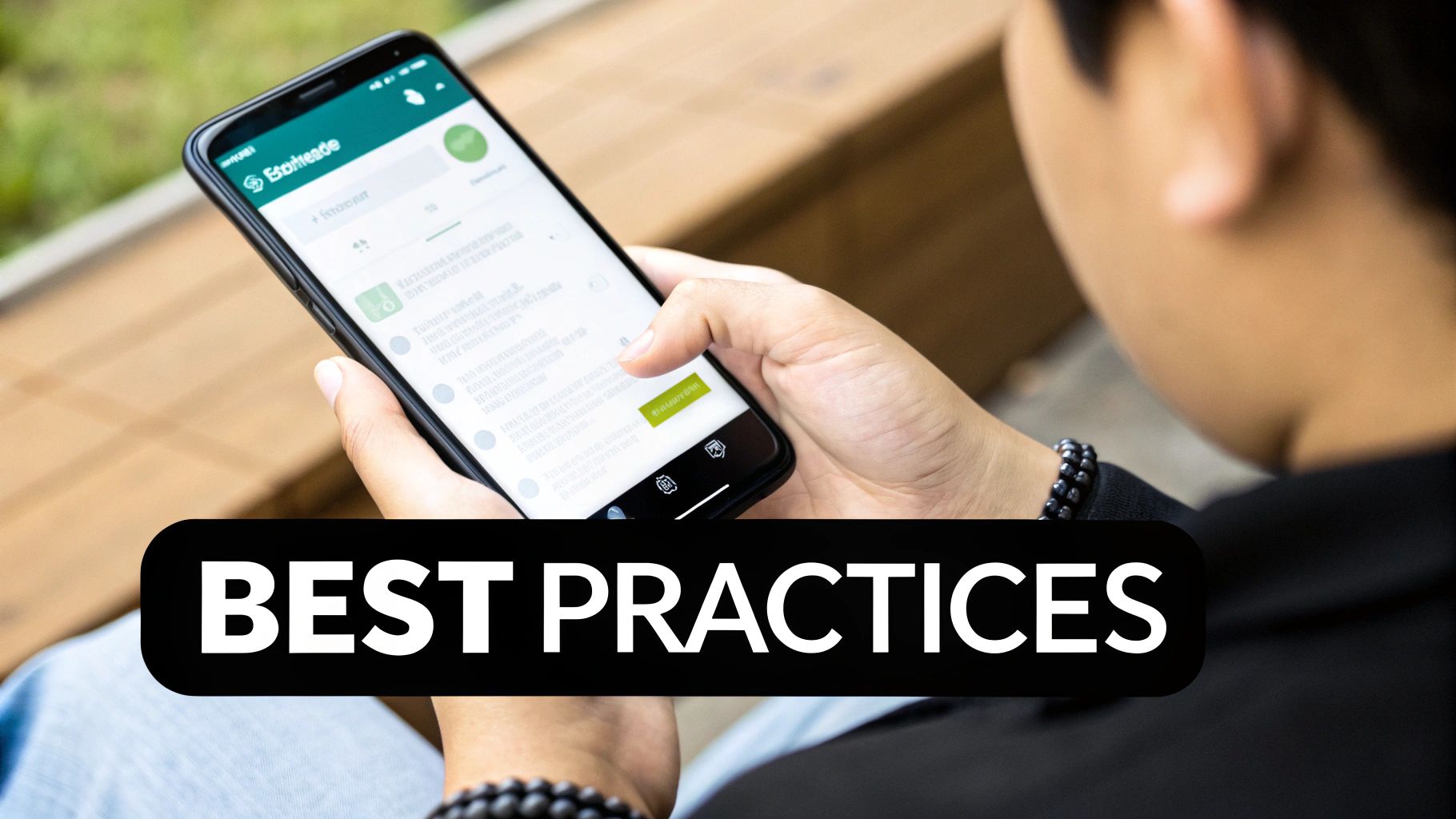
Once you’ve got the technical side sorted, the real work begins: crafting your broadcast message in WhatsApp. The goal is to make a message sent to hundreds of people feel like a one-to-one chat. It's all about delivering genuine value, not just another pushy sales pitch.
Remember: you've been invited into your customer's most personal digital space. Every message has to earn its right to be there. This requires a small but crucial shift in mindset, moving from "What can I sell?" to "How can I help?".
This subtle change is what separates a welcome notification from an annoying buzz. It turns a broadcast from a simple announcement into a genuine opportunity to build a stronger connection with your customers.
Writing Copy That Feels Personal
The secret to a great broadcast is to sound human. Ditch the corporate jargon and stiff language. Instead, write like you're messaging a friend. A warm, approachable tone goes a long way, and it’s the perfect place to let your brand's personality shine.
Even without the ability to auto-insert names in a standard broadcast, you can still make the message feel personal. A simple trick is to reference the list they’re on, making it feel like an exclusive club.
- For a local bakery: "Hi to everyone on our 'Weekend Treats' list! We've just pulled a fresh batch of sourdough out of the oven. We've put one aside for you if you can pop in before 2 pm."
- For a service provider: "Just a quick tip for our 'New Client' group: did you know you can get better results by doing X? Let me know if you have any questions!"
See how these messages feel both exclusive and genuinely helpful? That’s what gets people to engage.
The most effective broadcasts give your audience immediate value. Whether that’s a special discount, a genuinely useful tip, or early access to a new product, they should feel like they've gained something just by being on your list.
Turning Announcements into Action
Every broadcast needs a clear goal. What do you want the person to do after reading your message? Your call-to-action (CTA) must be simple, direct, and incredibly easy to act on.
Vague requests like "check out our website" just don't cut it. You have to be specific.
- Weak CTA: Visit our site for more.
- Strong CTA: Tap here to get 20% off all jackets today only: [Your Link]
The stronger example creates urgency and clearly spells out the benefit, making it an easy choice for the customer.
Ultimately, the goal is to start a conversation. A well-written broadcast message in WhatsApp doesn't just talk at people; it invites them to reply. By focusing on giving real value and writing in a personal, relatable way, you’ll find your broadcasts become powerful tools for building real customer relationships.
Real-World Strategies for Effective Broadcasting
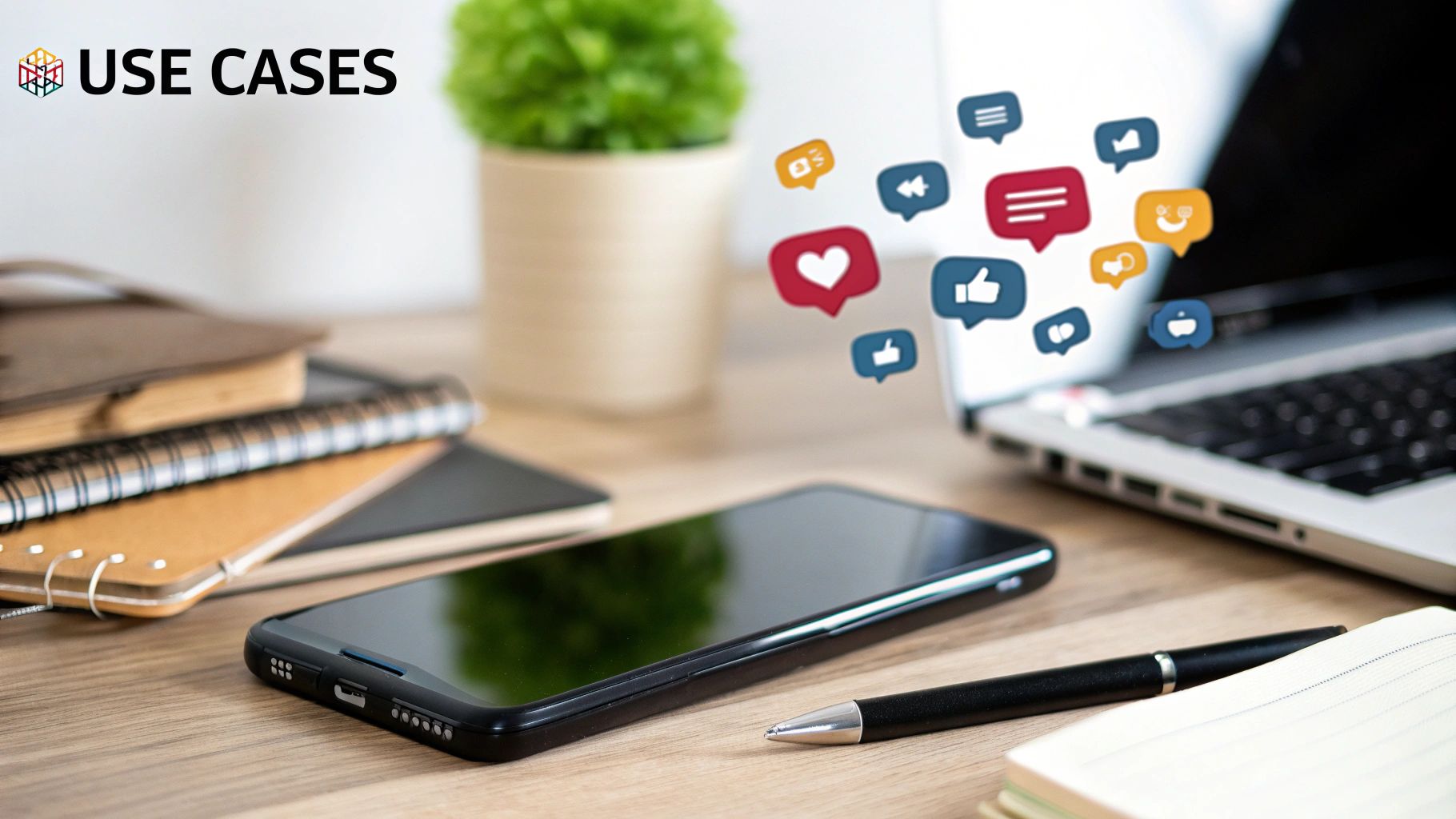
Sending the message is just the first step. The real art is sending one that actually works—one that your customers welcome and act on, rather than dismissing as spam. A great broadcast strategy is all about respecting your customer's time and their inbox.
Before you send a single message, you need clear, enthusiastic consent. This means people know exactly what they’re signing up for before you add them to any list. It’s not just about ticking a box; it’s the foundation of a trusting relationship and aligns perfectly with privacy expectations in the UK.
Finding Your Rhythm
Once you've got that crucial go-ahead, it's all about timing and frequency. Bombarding people with messages every day is a surefire way to get yourself blocked. The goal is to find a sweet spot—a rhythm that keeps you top-of-mind without becoming a nuisance.
Think about when your audience is most likely to be paying attention. If you’re a café advertising a lunch special, a message around 11 am makes sense. But if you’re a B2B consultancy, sticking to standard business hours will almost always get you better results.
A well-timed broadcast message in WhatsApp can do more than just make an announcement; it can kickstart a meaningful one-on-one conversation. When a customer replies, you've opened a direct line to answer questions, provide support, and build a lasting relationship.
Encouraging a Response
Every broadcast should have a clear purpose. You need to guide the reader towards taking a specific, simple action. A compelling call-to-action (CTA) is what separates a message that gets read from one that gets results.
- Be Direct: Instead of a vague "check out our offers," try something punchy like, "Tap here to claim your 25% discount code."
- Ask a Question: A simple question can work wonders. Finishing with, "Would you like me to reserve one for you?" makes it feel personal and prompts an easy reply.
This approach is incredibly effective in the UK, where WhatsApp is part of daily life. With 83% of users opening the app every day, your carefully crafted message has an excellent chance of being seen. You can find more insights into UK WhatsApp usage on esendex.co.uk.
By respecting consent and delivering timely, valuable content, you turn broadcasting from a simple function into a powerful way to connect with your customers.
Common Broadcast Pitfalls and How to Sidestep Them
Even with a solid strategy, small missteps can derail your WhatsApp broadcasts. Knowing these common tripwires is the best way to keep your audience engaged and ensure your messages actually get delivered.
The most common problem? Messages simply not arriving. Nine times out of ten, the reason is surprisingly simple: your customer hasn't saved your business number to their phone's contacts. This is a core spam prevention feature built into WhatsApp, and there's no technical workaround for it.
How to Get Customers to Save Your Number
Don't just ask them to save your number; give them a good reason to do it. The best time to make the request is right after they first contact you. You can offer a small, immediate incentive that benefits them directly.
For example, set up an automated welcome message that says something like: "Thanks for getting in touch! To make sure you don't miss our updates, save this number to your contacts and reply 'DONE' to get a 10% discount code for your next order."
This simple move accomplishes three things at once:
- It gives the customer immediate value.
- It ensures they'll receive your future broadcasts.
- It kicks off your relationship with a positive, helpful interaction.
The quickest way to harm your sender reputation is by getting marked as spam. This usually happens when you send irrelevant messages, broadcast too often, or add people without getting their explicit consent first. Always focus on providing value, not just sending another message.
By framing the "save our number" request as a clear benefit for the customer, you proactively solve the biggest delivery issue you'll face. It’s a tiny tweak that has a massive impact on the success of every broadcast message in WhatsApp you send down the line.
Answering Your Top WhatsApp Broadcast Questions
Diving into WhatsApp broadcasts for your business? It's natural to have a few questions. Here are the answers to the most common ones we see.
Will My Customers See Each Other in the Broadcast?
This is a big one, and the answer is a firm no. One of the greatest advantages of using a broadcast message in WhatsApp is the privacy it offers.
Each person on your list receives the message as a standard, one-to-one chat directly from you. They will have no idea who else received it, making it feel personal while protecting everyone's details.
Why Aren't My Broadcast Messages Delivering to Everyone?
This is easily the most common snag people hit. If you notice your messages aren't reaching certain contacts, there's a very simple reason: they haven't saved your business number to their phone.
WhatsApp put this rule in place to stop spam, so it’s essential. From your very first interaction, make a point of encouraging new customers to save your number.
Think of it this way: earning a spot in your customer's contact list is the key that unlocks successful broadcasting. It’s a sign of trust that ensures your messages are always welcome.
How Many People Can I Add to a Broadcast List?
There is a cap. Each broadcast list you create can hold a maximum of 256 contacts.
At first glance, that might seem limiting, but it actually encourages a much smarter strategy. Instead of blasting one generic message to everyone, you can build several smaller, targeted lists based on customer interests, purchase history, or location. This way, every broadcast you send feels relevant and is far more likely to get a response.
Ready to separate your business and personal chats with a dedicated virtual number? Business Numbers Direct offers an affordable, no-contract solution to get your professional WhatsApp Business profile up and running in minutes. Get your virtual number today at https://www.businessnumbersdirect.com.

